- Clone
- 6H6 (See other available formats)
- Regulatory Status
- RUO
- Other Names
- IL-3Rα, IL-3 Receptor alpha
- Isotype
- Mouse IgG1, κ
- Ave. Rating
- Submit a Review
- Product Citations
- publications
CD123 is the 70 kD transmembrane α chain of the IL-3 receptor. Alone, CD123 binds IL-3 with low affinity; when CD123 associates with CD131 (common β chain), it binds IL-3 with high affinity. CD123 does not transduce intracellular signals upon binding IL-3 and requires the β chain for this function. CD123 is expressed by myeloid precursors, macrophages, dendritic cells, mast cells, basophils, megakaryocytes, and some B cells.
Product DetailsProduct Details
- Verified Reactivity
- Human
- Reported Reactivity
- Rhesus
- Antibody Type
- Monoclonal
- Host Species
- Mouse
- Immunogen
- Human IL-3Rα transfected COS cells.
- Formulation
- Phosphate-buffered solution, pH 7.2, containing 0.09% sodium azide
- Preparation
- The antibody was purified by affinity chromatography and conjugated with Spark Red™ 718 under optimal conditions.
- Concentration
- 0.2 mg/mL
- Storage & Handling
- The antibody solution should be stored undiluted between 2°C and 8°C, and protected from prolonged exposure to light. Do not freeze.
- Application
-
FC
- Recommended Usage
-
Flexi-Fluors™ are provided at a standard 0.2 mg/mL concentration. We recommend titrating this reagent to determine the optimal concentration for each application. For many flow cytometry applications, conjugated antibodies perform well at concentrations ranging from 0.03 to 1.0 µg per million cells in 100 µL. We recommend testing a range of concentrations starting from 10 µg/mL.
For example, make five 1:1 serial dilutions of the 0.2 mg/mL antibody. Add 5 µL of each dilution (including the undiluted antibody) to 100 µL of cells (at 107 cells/mL) to test six concentrations -- 1.0, 0.5, 0.25, 0.125, 0.06, and 0.03 µg per million cells in 100 µL volume. Compare staining patterns or create a titration curve using the MFI or staining index to determine the optimal concentration.
* Spark Red™ 718 has a maximum excitation of 697 nm and a maximum emission of 711 nm. - Excitation Laser
-
Red Laser (633 nm)
- Application Notes
-
Clone 6H6 does not inhibit IL-3 binding to low- or high-affinity IL-3Rs. Additional reported applications (for the relevant formats) include: Western blotting1, immunoprecipitation1, and immunohistochemical staining of acetone-fixed frozen sections2 and also paraformaldehyde fixed paraffin embedded tissue7.
- Additional Product Notes
-
For more information about Flexi-Fluors™, visit our Flexi-Fluor™ page and review FAQs associated with this product line.
- Application References
-
- Sun Q, et al. 1996. Blood 87:83. (IP, WB)
- Herling M, et al. 2003. Blood 101:5007. (IHC)
- Charles N, et al. 2010. Nat. Med. 16:701. (FC) PubMed
- Martin-Gayo E, et al. 2010. Blood 115:5366. PubMed
- Chen SC, et al. 2010. Arch Dermatol Res. 302:113. PubMed
- Liu Y, et al. 2012. Food Chem Toxicol. 50:1920. PubMed
- Peduzzi E, et al. 2007. J. Invest. Dermatol. 127:638. (IHC)
- RRID
-
AB_3106316 (BioLegend Cat. No. 285054)
Antigen Details
- Structure
- Ig superfamily, type I transmembrane glycoprotein, associates with CDw131, 70 kD
- Distribution
-
Myeloid precursors, basophils, mast cells, macrophages, dendritic cells, megakaryocytes, subset of lymphocytes
- Function
- Hematopoietic cell proliferation, differentiation
- Ligand/Receptor
- IL-3
- Cell Type
- Basophils, Dendritic cells, Hematopoietic stem and progenitors, Lymphocytes, Macrophages, Mast cells, Megakaryocytes
- Biology Area
- Immunology
- Molecular Family
- CD Molecules, Cytokine/Chemokine Receptors
- Antigen References
-
1. Miyajima A, et al. 1993. Blood 82:1960.
- Gene ID
- 3563 View all products for this Gene ID
- UniProt
- View information about CD123 on UniProt.org
Related FAQs
- What are Flexi-Fluors?
-
Flexi-Fluors are rapidly made-to-order conjugated antibodies. The technology, manufacturing processes, and specifications used to create Flexi-Fluors are the same as our regular catalog products. However, the optimal concentration and performance of each Flexi-Fluor must be determined by the customer.
- How quickly will I receive my order?
-
We aim to ship Flexi-Fluors within 2-3 weeks of receipt of your order. However, depending on your location, shipping times may vary.
- How are Flexi-Fluors different from regular catalog products?
-
Flexi-Fluors are made on demand, specifically for you. Flexi-Fluors are manufactured using the same high-quality standards, and specifications as other catalog products. For faster delivery, Flexi-Fluors are not tested by flow cytometry to determine optimal concentrations or evaluate performance. This testing needs to be performed by the customer.
- How do I determine the optimal concentration for using my Flexi-Fluor? How should I titrate my antibody?
-
Flexi-Fluors are provided at a standard 0.2 mg/mL concentration. We recommend that you titrate your antibody to determine the optimal concentration to use for your application. For many flow cytometry applications, conjugated antibodies perform well at concentrations ranging from 0.03 to 1.0 µg per million cells in 100 µL volume. We recommend that you test a range of concentrations starting from 10 µg/mL.
For example, make five 1:1 serial dilutions of your 0.2 mg/mL antibody. Add 5 µL of each dilution (including the undiluted antibody) to 100 µL of cells (at 107 cells/ml) to test six concentrations - 1.0, 0.5, 0.25, 0.125, 0.06, and 0.03 µg per million cells in 100 µL volume. Compare staining patterns or create a titration curve using the MFI or staining index to determine the optimal concentration.
- I can’t find the antibody-dye combination that I need. When will it be available?
-
We continuously update our catalog, introducing scores of new products every month. Please get in touch with our Technical Service team for an update on new products or recommendations for suitable alternatives to complete your panel. Or contact Custom Solutions to inquire about our affordable custom conjugation services.
- I need help to validate the performance of my Flexi-Fluor. Who should I contact?
-
Please get in touch with Technical Service for assistance.
- Can I order more than 50 μg of a Flexi-Fluor?
-
Yes, you can order multiple vials of the same Flexi-Fluor products. We cannot guarantee, however, that these vials will be bottled from the same lot. For bulk single-lot orders, contact our Custom Solutions team.
- What is the expiration date of my Flexi-Fluor?
-
Expiration dates can be found on the vial label or by using our CoA lookup tool.
Other Formats
View All CD123 Reagents Request Custom ConjugationCompare Data Across All Formats
This data display is provided for general comparisons between formats.
Your actual data may vary due to variations in samples, target cells, instruments and their settings, staining conditions, and other factors.
If you need assistance with selecting the best format contact our expert technical support team.
-
Biotin anti-human CD123

Human peripheral blood lymphocytes stained with 6H6 PE and C... -
PE anti-human CD123

Human peripheral blood lymphocytes stained with 6H6 PE and C... 
Multiplexed IHC staining of PE anti-CD123 (clone 6H6) on for... -
Purified anti-human CD123

Human peripheral blood lymphocytes stained with 6H6 PE and C... -
PE/Cyanine5 anti-human CD123

Human peripheral blood lymphocytes stained with CD45RO FITC ... -
PE/Cyanine7 anti-human CD123

Human peripheral blood lymphocytes stained with CD45RO FITC ... -
APC anti-human CD123
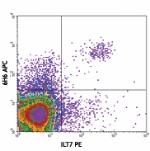
CD14- human peripheral blood mononuclear cells stained with ... -
FITC anti-human CD123
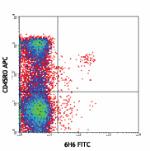
Human peripheral blood leukocytes stained with CD45RO APC an... -
PerCP/Cyanine5.5 anti-human CD123

Human peripheral blood lymphocytes stained with CD123 (clone... -
Brilliant Violet 421™ anti-human CD123
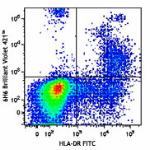
Human peripheral blood leukocytes were stained with HLA-DR F... 
-
Brilliant Violet 650™ anti-human CD123
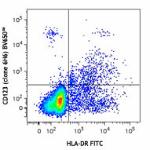
Human peripheral blood leukocytes were stained with HLA-DR F... 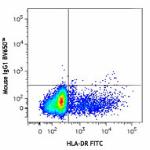
-
Brilliant Violet 510™ anti-human CD123
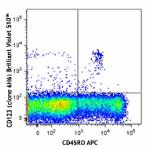
Human peripheral blood lymphocytes were stained with CD45RO ... 
-
Alexa Fluor® 647 anti-human CD123
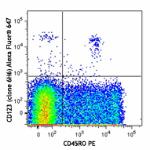
Human peripheral blood lymphocytes were stained with CD45RO ... 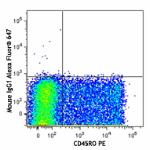
-
Brilliant Violet 605™ anti-human CD123
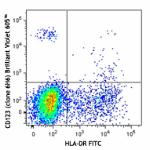
Human peripheral blood lymphocytes were stained with HLA-DR ... 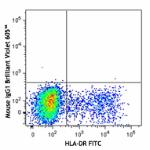
-
Purified anti-human CD123 (Maxpar® Ready)
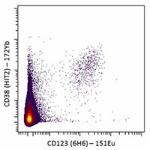
Human lysed whole blood stained with 151Eu anti-CD123 (6H6) ... -
Brilliant Violet 711™ anti-human CD123
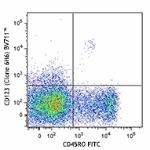
Human peripheral blood lymphocytes were stained with CD45RO ... 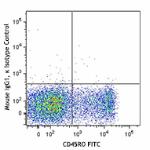
-
Brilliant Violet 785™ anti-human CD123
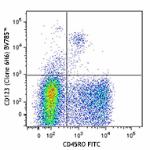
Human peripheral blood lymphocytes were stained with CD45RO ... 
-
PE/Dazzle™ 594 anti-human CD123
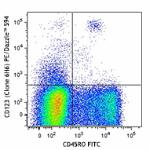
Human peripheral blood lymphocytes were stained with CD45RO ... 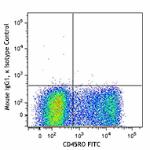
-
Alexa Fluor® 488 anti-human CD123
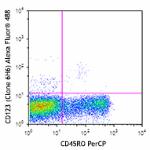
Human peripheral blood lymphocytes were stained with CD45RO ... 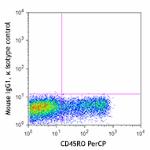
-
PE/Cyanine7 anti-human CD123
Typical results from human peripheral blood lymphocytes stai... -
TotalSeq™-A0064 anti-human CD123
-
Alexa Fluor® 700 anti-human CD123

Human lysed whole blood was stained with CD45RO FITC and CD... -
APC/Fire™ 750 anti-human CD123

Human lysed whole blood was stained with CD45RO FITC and CD1... -
Pacific Blue™ anti-human CD123

Human lysed whole blood was stained with CD45RO FITC and CD1... -
TotalSeq™-C0064 anti-human CD123
-
TotalSeq™-B0064 anti-human CD123
-
TotalSeq™-D0064 anti-human CD123
-
PerCP anti-human CD123

Human peripheral blood lymphocytes were stained with CD45RO ... -
GMP PE/Cyanine7 anti-human CD123

Typical results from human peripheral blood lymphocytes stai... -
APC/Fire™ 810 anti-human CD123 Antibody

Human peripheral blood lymphocytes were stained with anti-hu... -
APC anti-human CD123

Typical results from Human peripheral blood lymphocytes stai... -
PE anti-human CD123
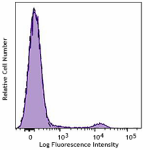
Typical results from Human peripheral blood lymphocytes stai... -
Pacific Blue™ anti-human CD123

Typical results from Human peripheral blood lymphocytes stai... -
Spark Red™ 718 anti-human CD123 (Flexi-Fluor™)
-
PerCP anti-human CD123

Typical results from human peripheral blood lymphocytes stai... -
PerCP/Cyanine5.5 anti-human CD123

Typical results from human peripheral blood lymphocytes stai...

 Login / Register
Login / Register 










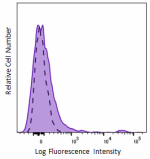



Follow Us